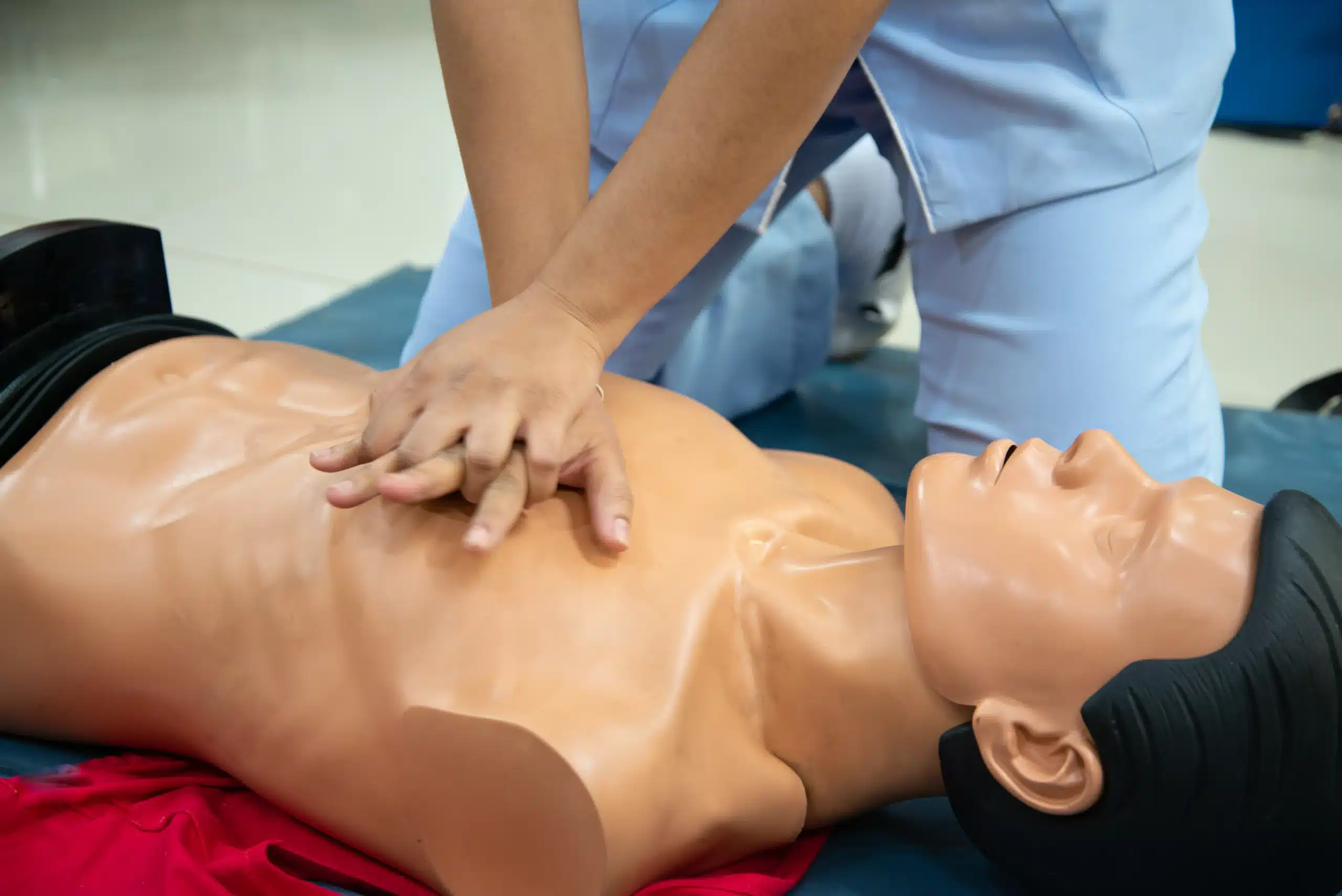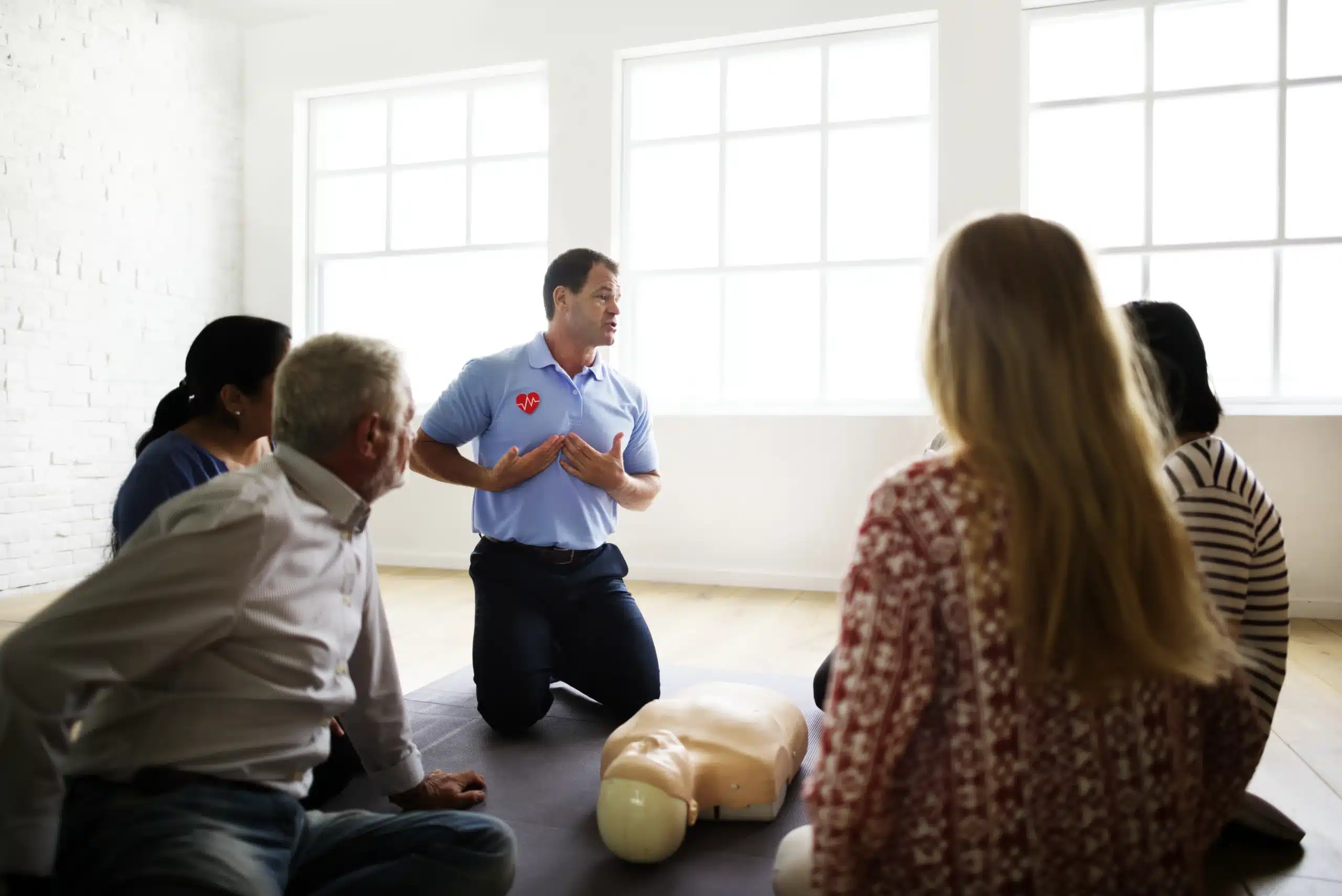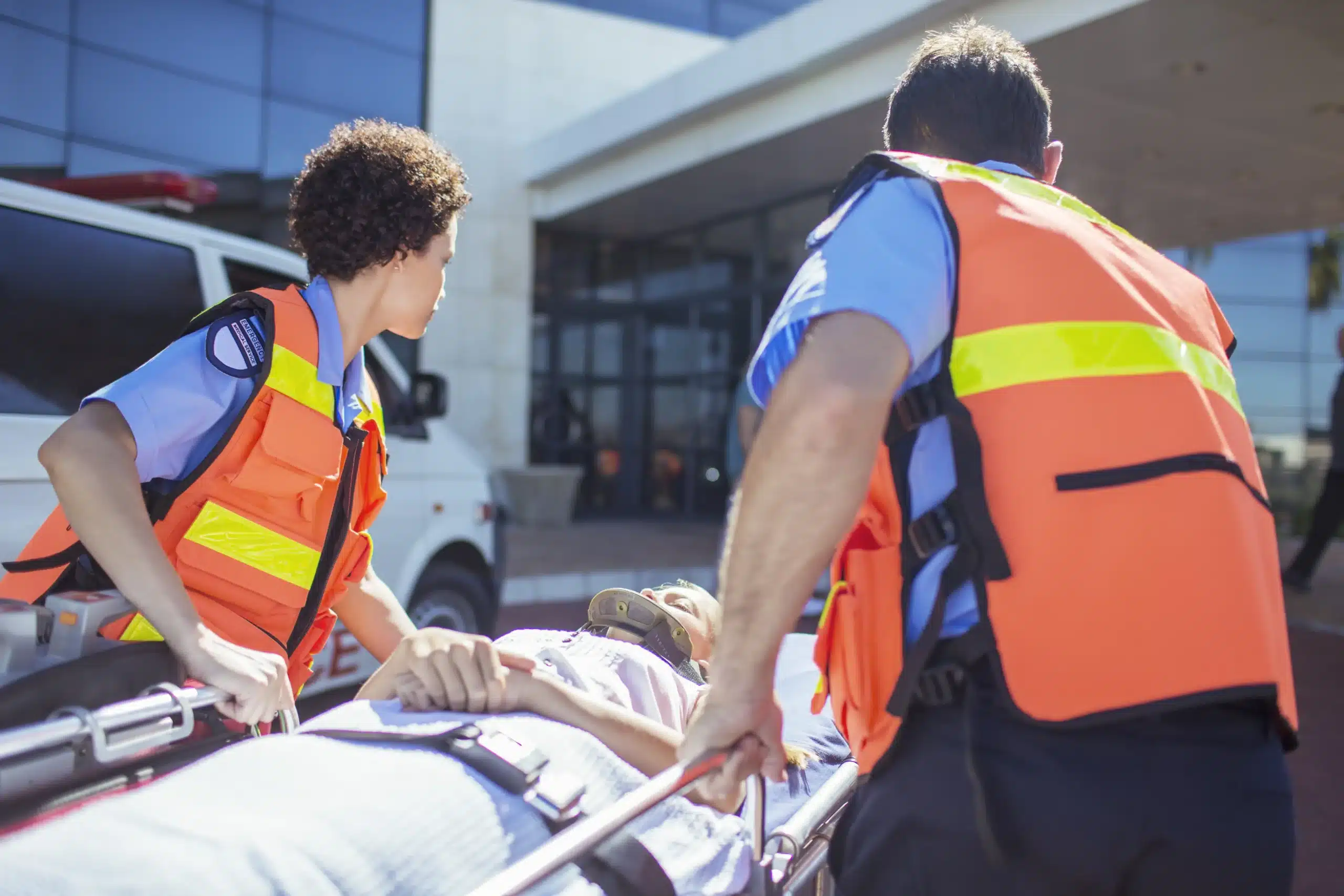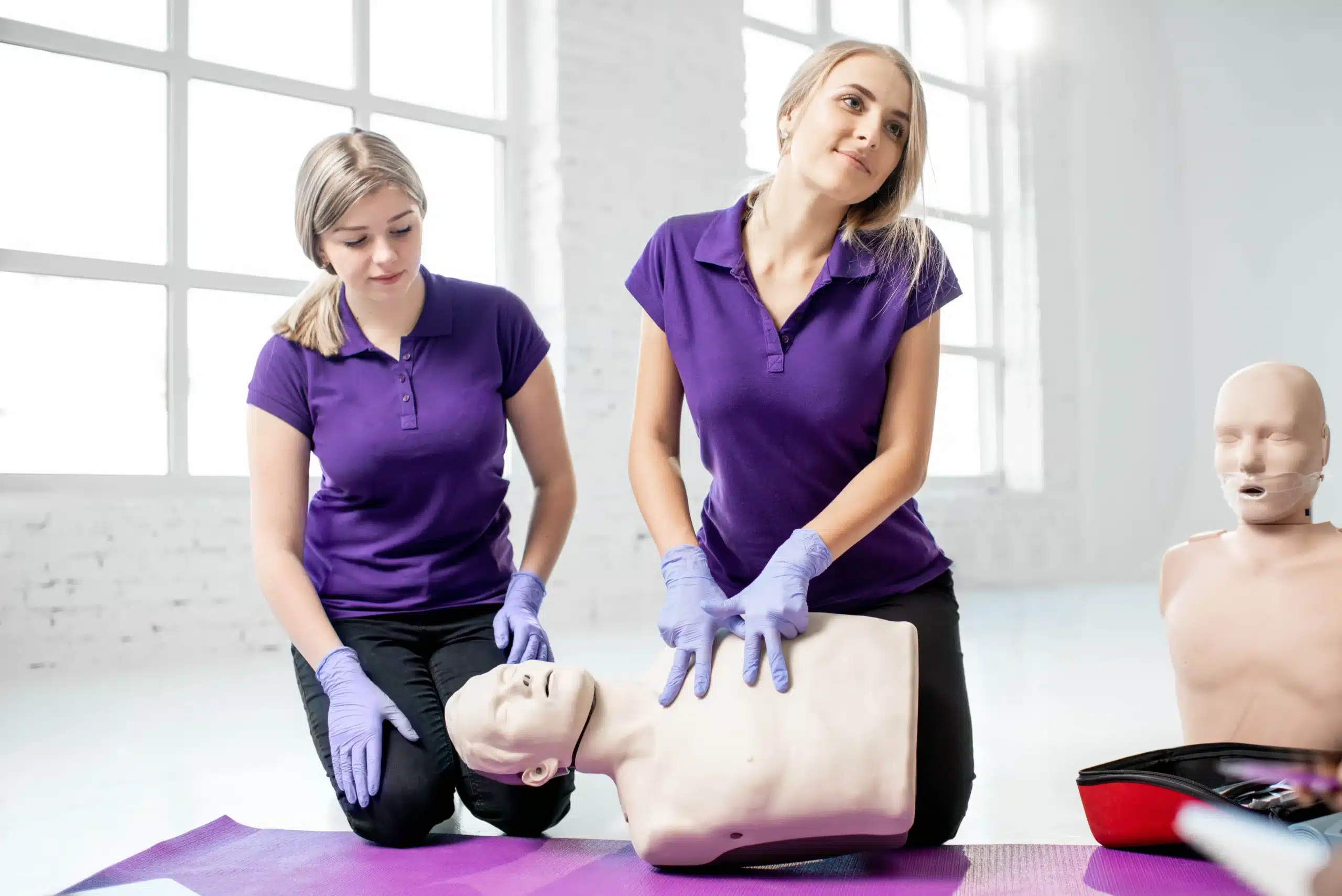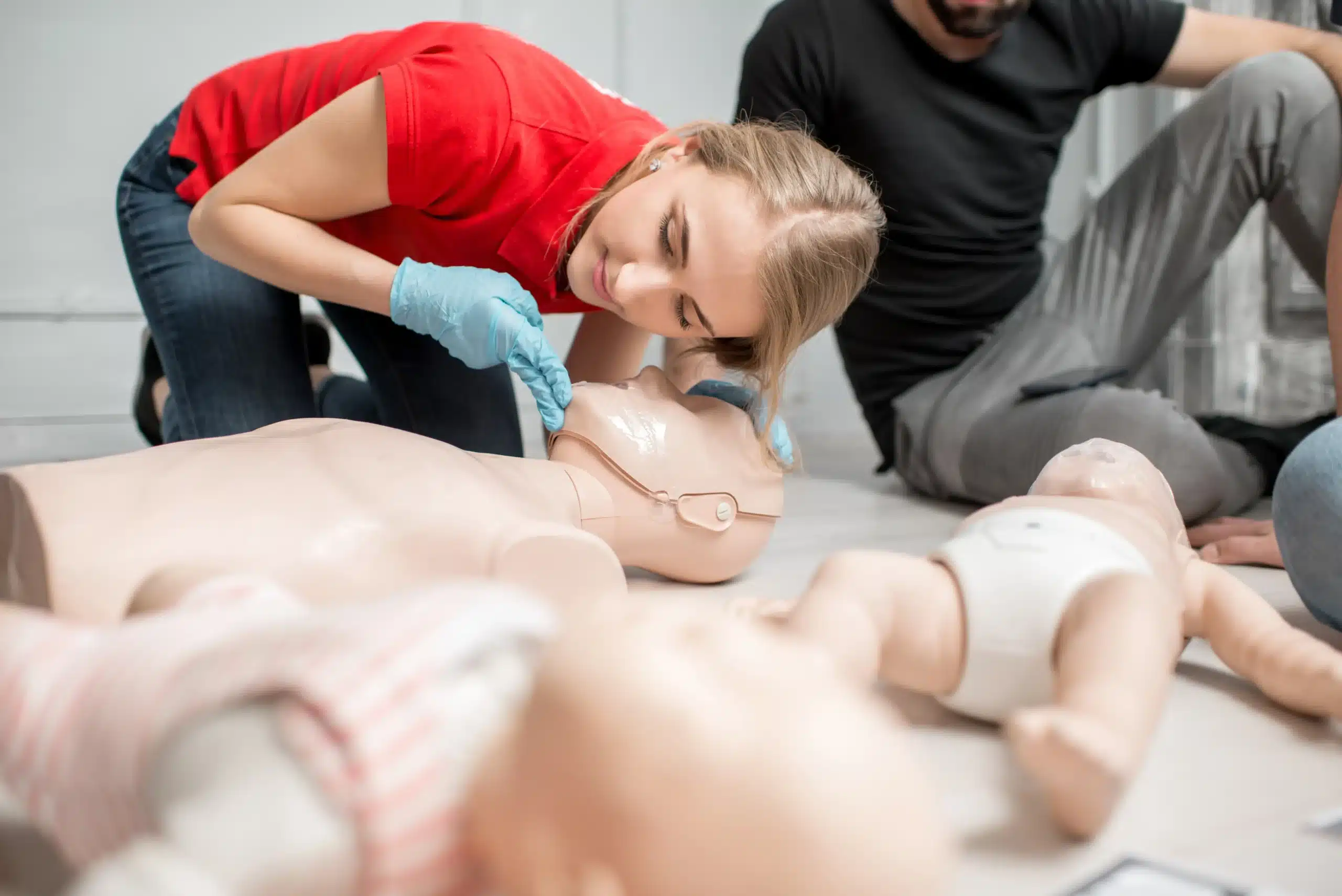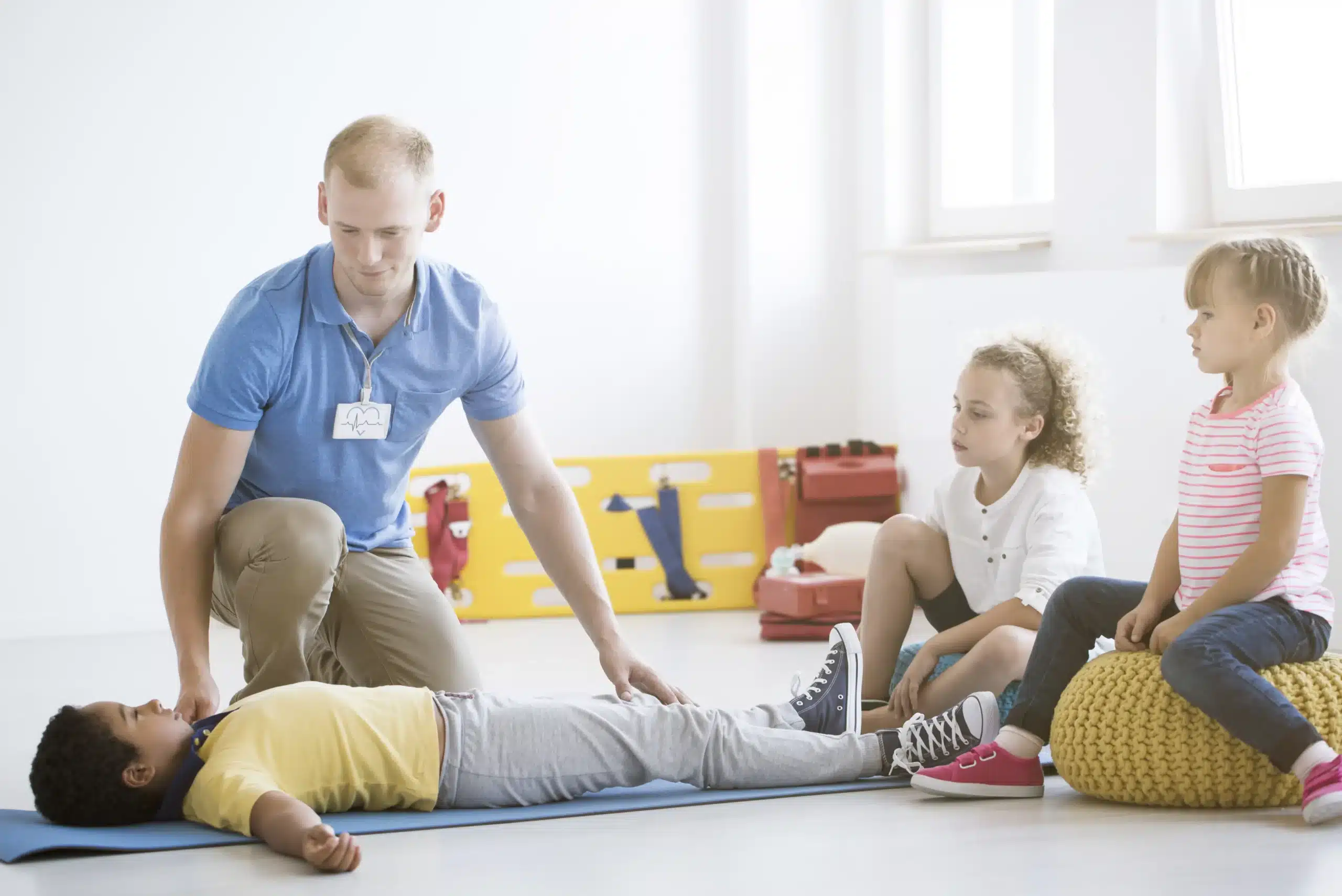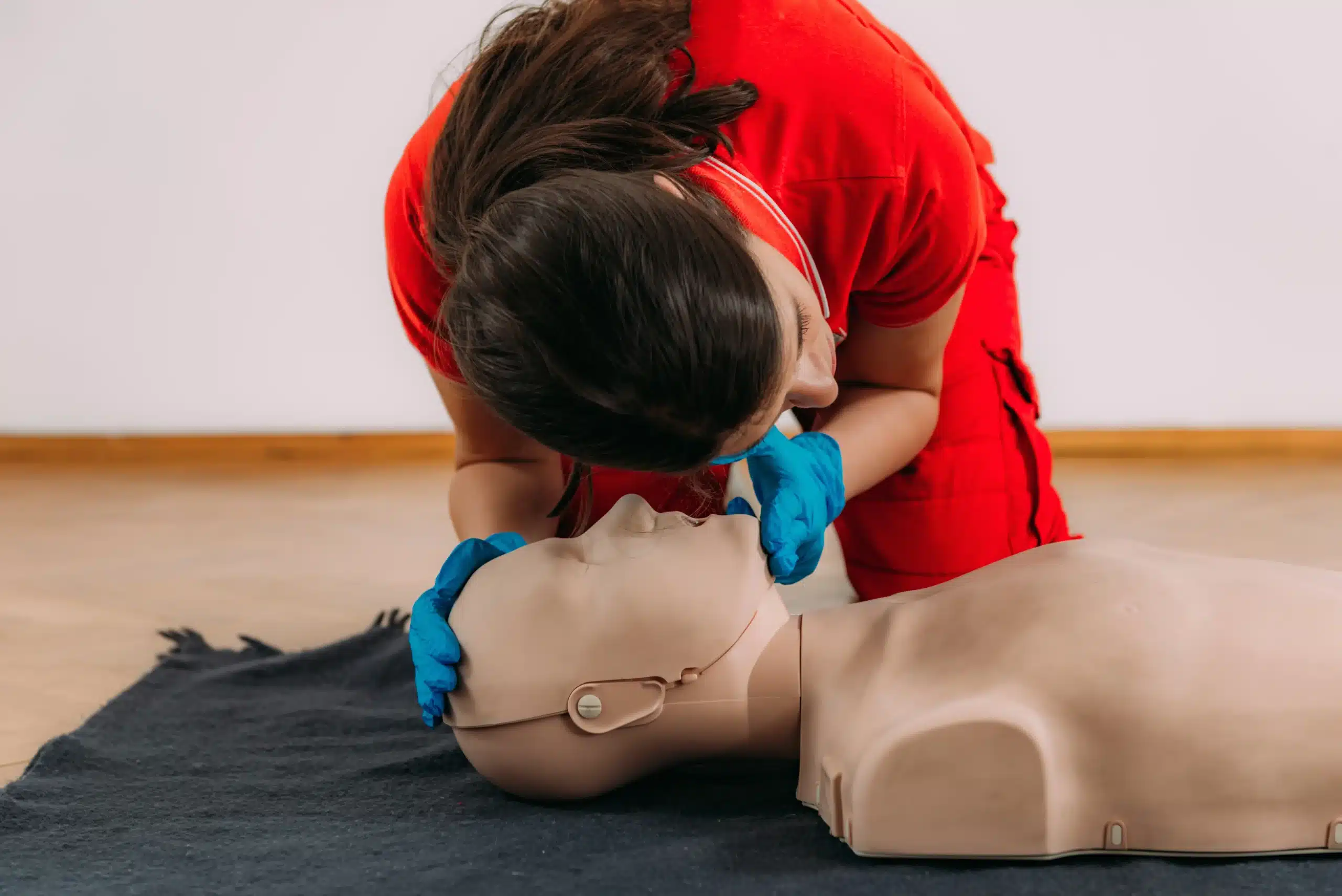Emergencies happen, and knowing how to respond can make all the difference. If you’re looking for CPR and first-aid in Tracy, this guide is your starting point. We’ll walk you through the various types of training available, from basic CPR to advanced life support, and help you understand which certification is right for you. We’ll also cover costs, schedules, and top training providers in the area, so you can find a class that fits your needs and budget. Plus, we’ll debunk some common CPR myths along the way. Let’s get you prepared.
Key Takeaways
- CPR and First Aid certifications empower you to respond to emergencies: Equipping yourself with these skills allows you to confidently handle various medical situations, benefiting yourself, your loved ones, and your community. Explore different certification levels to find the best fit for your needs.
- Safety Training Seminars offers accessible, high-quality training in Tracy: We provide a range of AHA-certified courses with flexible scheduling and competitive pricing, making it easier than ever to get certified. Visit our website to learn more and register for a class.
- Finding the right course involves assessing your needs and seeking flexible options: Determine why you want to pursue training and choose a course that aligns with your goals. Prioritize providers who offer convenient schedules, blended learning formats, and hands-on practice for a comprehensive learning experience.
What is CPR and First Aid Training in Tracy?
CPR (Cardiopulmonary Resuscitation) and First Aid training gives you the skills to respond effectively to emergencies. These programs in Tracy teach you how to save lives and handle medical crises, equipping you to make a real difference when it matters most. CPR focuses on restoring breathing and circulation, while First Aid covers a broader range of injuries and illnesses, from minor cuts to more serious situations. Learning both provides a well-rounded foundation for responding to various emergencies. Safety Training Seminars offers American Heart Association-certified courses in CPR, BLS (Basic Life Support), ACLS (Advanced Cardiovascular Life Support), PALS (Pediatric Advanced Life Support), and First Aid in Tracy. These courses are designed for both healthcare professionals and anyone who wants to be prepared. Classes often incorporate online learning and in-person skills tests, blending convenient online study with the hands-on practice needed to confidently apply your skills in real-world scenarios. The impact of these certifications extends beyond individual preparedness; they empower you to help your family, friends, coworkers, and community.
CPR and First Aid Classes Available
Safety Training Seminars offers a range of CPR and first aid classes in Tracy, CA, designed to meet diverse needs, from basic life support to specialized certifications. Let’s explore the different courses available:
Basic Life Support (BLS)
The BLS course provides healthcare providers and other professionals with the skills and knowledge to perform high-quality CPR for adults, children, and infants. It covers essential techniques like chest compressions, rescue breaths, and using an AED. This course is ideal for medical professionals, first responders, and anyone working in a healthcare setting. The American Heart Association certification ensures you receive training aligned with the latest CPR guidelines.
Advanced Cardiovascular Life Support (ACLS)
The ACLS course is designed for healthcare professionals who manage cardiopulmonary arrest or other cardiovascular emergencies. It builds upon the foundation of BLS and covers advanced airway management, pharmacology, and team dynamics during resuscitation. Safety Training Seminars offers the convenient Resuscitation Quality Improvement (RQI) program for maintaining your ACLS certification.
Pediatric Advanced Life Support (PALS)
PALS focuses on the specialized approach required for pediatric emergencies. This course teaches healthcare providers how to recognize and respond to life-threatening situations in infants and children. The PALS HeartCode blended learning option combines online coursework with a hands-on skills session, offering flexibility for busy professionals. This format allows you to learn the material at your own pace and then practice the essential skills in person.
First Aid Certification
A first aid certification equips you with the skills to handle common medical emergencies like bleeding, burns, allergic reactions, and choking. These courses meet OSHA requirements and provide practical knowledge applicable in various settings, from the workplace to the home. Certifications are typically valid for two years, ensuring your skills remain up-to-date.
Specialized Courses
Beyond the core offerings, Safety Training Seminars provides specialized courses tailored to specific needs. These include the EMSA Child Care Health & Safety program, designed for childcare providers. You can explore their website for a complete list of available courses and find the training that best fits your professional requirements.
Top CPR and First Aid Training Providers in Tracy
Finding the right CPR and first aid training provider is crucial for receiving quality instruction and a nationally recognized certification. Here are a few reputable providers in the Tracy area:
Safety Training Seminars
Safety Training Seminars offers a range of American Heart Association-certified courses, including CPR, BLS, ACLS, PALS, and First Aid. They serve Tracy and surrounding cities, making their training accessible to a wider audience. Explore their course schedule and find a class that fits your needs. Their nationally recognized certifications ensure your training meets industry standards.
Bay Area CPR
Bay Area CPR provides American Heart Association-certified CPR, BLS, ACLS, and PALS classes in Tracy and nearby areas like Livermore and Modesto. With daily classes and online components for select courses, they offer flexibility for busy schedules.
Golden State Health and Safety Solutions
Golden State Health and Safety Solutions focuses on equipping individuals with essential, life-saving skills through comprehensive CPR and First Aid training. Check out their available classes in Tracy. They prioritize emergency preparedness, making their training valuable for both individuals and organizations. Participants receive CPR certification upon completion.
In-Home CPR
In-Home CPR brings the training to you, offering CPR, First Aid, and BLS certification courses at your home or office in Tracy and surrounding areas. With classes seven days a week, including evenings, and no minimum student requirements, they offer a convenient option for individuals or groups.
Costs and Value
Getting CPR and first aid certified is an investment in yourself and your community. But of course, you’ll want training that fits your budget. Let’s break down the costs associated with CPR and first aid training in Tracy and look at the real value these skills provide.
Individual Course Pricing
CPR and first aid course pricing varies depending on the type of certification you need. Basic CPR/AED/First Aid certification typically starts around $25, while more advanced certifications like BLS for Healthcare Providers are usually priced around $35. Safety Training Seminars offers competitive pricing on all its courses, making these essential skills accessible to everyone. Check out our website for a detailed price list.
Package Deals and Discounts
If you’re looking to get certified in multiple areas, or if you’re coordinating training for a group, look for package deals and discounts. Many providers, including Safety Training Seminars, offer reduced rates for group classes and combined certifications like CPR/First Aid/BLS. This can be a smart way to save money while ensuring everyone gets the training they need. Contact us to learn more about group discounts.
Low Price Guarantee
Safety Training Seminars is committed to providing high-quality training at the most affordable rates. We’re proud to offer the lowest prices in San Joaquin County. This commitment helps ensure that cost isn’t a barrier to learning these vital skills.
Compare Costs with Benefits
While understanding the upfront costs of training is important, it’s equally important to consider the long-term value. Think about the potential impact of knowing how to respond effectively in a medical emergency. The ability to provide immediate assistance to a loved one, a colleague, or even a stranger can be priceless. The confidence and skills you gain through CPR and first aid training far outweigh the initial investment, offering peace of mind and potentially life-saving benefits.
Instructor Qualifications and Training Methods
Knowing your instructor’s background and the training methods used can help you choose the right CPR and first aid class. Look for courses that prioritize hands-on training, real-world scenarios, and instructors with relevant medical experience.
Medical Professional Backgrounds
Instructors with backgrounds as EMTs, paramedics, or registered nurses bring valuable real-world experience to the classroom. This practical knowledge makes instruction more effective, giving you confidence in your ability to respond to emergencies. Some providers, like In-Home CPR, focus on using medical professionals as instructors. This ensures you learn from individuals with current, hands-on experience in emergency medical situations.
American Heart Association Certification
Certification by the American Heart Association (AHA) sets the standard for CPR and first aid training. AHA-certified courses, such as those offered by Safety Training Seminars, follow the latest scientific guidelines and best practices. This ensures your certification is widely recognized and respected. An AHA-certified course provides you with credentials essential for many healthcare and professional settings.
Hands-on Practice and Real-life Scenarios
Effective CPR training goes beyond lectures and videos. Look for classes that include hands-on practice with equipment like voice-activated mannequins (VAMs). Bay Area CPR uses VAMs in their skills testing, allowing students to practice in a realistic, self-directed environment. This practical experience builds muscle memory and confidence, preparing you to act quickly and effectively during a real emergency. Simulating real-life scenarios also helps you apply your knowledge under pressure.
Accommodations
CPR training can be physically demanding. If you have any physical limitations, discuss them with the training provider before registering for a CPR class. Reputable providers understand these concerns and can offer guidance or alternative arrangements. Knowing that accommodations are available ensures everyone can participate and receive the necessary training. Don’t hesitate to ask about rescheduling options if needed.
Register and Get Certified
Getting certified in CPR and first aid is straightforward with Safety Training Seminars. We offer streamlined registration and certification processes to equip you for emergencies.
Online and In-Person Registration
Register online or in person—whatever works best for you. Check our website for our course calendar and register for a class that fits your schedule. Prefer in-person registration? Call us, and our team will gladly assist. We offer classes in Stockton and surrounding areas, including Tracy and Lodi.
Class Requirements
Our CPR training is hands-on and can be physically demanding. Consider your physical abilities before registering. If you have any concerns or physical limitations, contact us. We’re happy to discuss how we can accommodate you. Need to reschedule? We’re happy to help you find a different class time.
Digital Certification Cards
You’ll receive a digital certification card immediately upon completing your course. This gives you instant access to your certification—perfect for job applications or workplace requirements.
Certification Renewal
Your Safety Training Seminars certification is valid for two years and meets OSHA requirements. We make staying up-to-date easy and will send reminders when it’s time to renew. Learn more about our renewal process and our low price guarantee on our website.
Benefits of CPR and First Aid Training
Knowing CPR and first aid can make a real difference in various situations, from everyday mishaps to life-threatening emergencies. Let’s explore some key advantages of getting certified.
Personal Emergency Preparedness
Emergencies can happen anytime, anywhere. Having CPR and first aid training empowers you to respond effectively in such situations. Whether it’s a family member experiencing a medical crisis at home, a friend injured during a hike, or a stranger collapsing in a public place, your skills can be invaluable. Being prepared brings peace of mind, knowing you can act quickly and confidently when it matters most. For local resources and training options, check out CPR and first aid certification courses in Tracy.
Professional Development
For many healthcare professionals, CPR and first aid certification is a job requirement. The American Heart Association offers programs like BLS, ACLS, and PALS that enhance your credentials and demonstrate your commitment to providing high-quality care. Even outside the healthcare field, these certifications can strengthen your resume and open up new opportunities. Many employers value employees who are equipped to handle emergencies in the workplace. You can explore these certifications further on the Safety Training Seminars website.
Community Safety
CPR and first aid training contributes to a safer community overall. When more people are trained, the chances of someone being able to provide immediate assistance during an emergency increase. This creates a ripple effect, empowering individuals to help others and potentially save lives. Training courses often address common misconceptions about CPR and first aid, further strengthening community preparedness. Learn more about debunking common first aid myths.
Workplace Requirements
Many workplaces, particularly those with potential safety hazards, require employees to have CPR and first aid certification. This is often mandated by OSHA or other regulatory bodies. Having these certifications ensures that workplaces have trained personnel on hand to respond to medical emergencies and provide essential care until professional help arrives. This not only protects employees but also creates a safer work environment. The American Red Cross offers a comprehensive course covering adult, child, and infant CPR and first aid.
Choose the Right Course
Finding the right CPR and First Aid training boils down to three things: understanding your needs, comparing available courses, and prioritizing flexibility. Let’s break down each step to help you make the best decision.
Assess Your Needs
Before you jump into a course, think about why you’re pursuing this training. Are you required to have certification for your job as a healthcare provider, teacher, or childcare provider? Are you a parent or grandparent looking to gain skills for peace of mind? Or maybe you’re interested in volunteering in your community. Your reason will guide you toward the right level of certification. For example, healthcare professionals often require BLS certification, while community members might find a general CPR and First Aid course sufficient. Clearly defining your goals upfront will save you time and ensure you get the most relevant training.
Compare Courses and Schedules
Once you know what you need, it’s time to explore the options. Look at different providers and compare the courses they offer. Check what’s included in each course—some might focus solely on CPR, while others incorporate First Aid and AED training. Pay close attention to the class schedules. Do they offer weekend or evening classes to accommodate your work schedule? Safety Training Seminars offers a variety of courses, including CPR, BLS, ACLS, PALS, and First Aid. See if the course format works for you—some people prefer in-person instruction, while others appreciate the convenience of online learning. Consider factors like class size and location as well. A smaller class might offer more personalized attention, while a convenient location can save you travel time.
Flexible Options
Life gets busy, so finding a course that fits your schedule is essential. Look for providers who offer flexible options, such as weekend or evening classes, blended learning (a mix of online and in-person instruction), and varied class sizes. Some providers offer the convenience of training at your home or workplace. This can be a game-changer for busy professionals or groups who want to train together. Don’t be afraid to ask about options like rolling enrollment or accelerated programs if you’re on a tight deadline. The more flexible the training, the easier it will be to complete and get certified.
Debunking CPR Myths
It’s easy to get confused about CPR, especially with so much information—and misinformation—out there. Let’s clear up some common misconceptions so you can feel confident in your training.
CPR’s Role in Emergencies
One persistent myth is that CPR alone can restart a stopped heart. In reality, CPR primarily keeps blood and oxygen circulating. It buys precious time until professional medical help arrives with advanced life-saving equipment. Thinking CPR can single-handedly restart a heart can delay calling 911, which is crucial in cardiac arrest situations. CPR is a bridge, not the cure. This article further explains the truth about CPR.
Who Can Perform CPR
Another myth suggests only medical professionals can perform CPR effectively. This isn’t true at all. Anyone, even without formal medical training, can learn and administer CPR. Bystander CPR can significantly increase the chances of survival during cardiac arrest. Don’t let this myth prevent you from taking action in an emergency. Learn more about common CPR myths.
Mouth-to-Mouth Myths
Many people still believe mouth-to-mouth resuscitation is a mandatory part of CPR. Current guidelines prioritize chest compressions. While rescue breaths can be helpful in certain situations, compression-only CPR is often sufficient and easier for bystanders. This simplifies the process and encourages more people to act quickly without hesitation.
Online vs. In-Person Training
Finally, there’s a misconception that online CPR training is equivalent to in-person instruction. While online resources offer valuable information, they lack the crucial hands-on practice and feedback from certified instructors. In-person training allows you to develop muscle memory and confidence for performing CPR effectively under pressure. It also ensures proper technique, which is essential for positive outcomes.
Get Started With Your Training
Ready to become CPR and first aid certified? It’s easier than you think, and we’re here to guide you. Here’s how to start your training in Tracy:
First, explore the different CPR and first aid courses. Do you need basic CPR training, or are you a healthcare provider seeking advanced certification like ACLS or PALS? Understanding the different certifications helps you choose the right course. Safety Training Seminars offers a range of options, from basic CPR and first aid to specialized courses like EMSA Child Care Health & Safety.
Next, check the training schedule and find a date and time that works for you. We offer daily classes to accommodate busy schedules. Registering is simple and can be done online. Many providers offer blended learning, allowing you to complete some coursework online at your own pace before an in-person skills session. This flexible approach makes training convenient.
We understand cost is a factor. Check our low price guarantee and compare our prices. We’re committed to providing high-quality, affordable training in San Joaquin County. You’ll find transparent and competitive pricing.
Finally, remember that getting certified is about gaining the confidence and skills to potentially save a life. Whether you’re a parent, teacher, healthcare worker, or someone who wants to be prepared, CPR and first aid training empowers you to make a difference.
Related Articles
- Pediatric CPR & First-Aid Classes in Tracy – Stockton CPR Classes
- Pediatric Advanced Life Support (PALS) in Tracy – Stockton CPR Classes
- BLS Certification in Tracy: Your Comprehensive Guide – Stockton CPR Classes
- ACLS Certification in Tracy: Your Comprehensive Guide – Stockton CPR Classes
- PALS HeartCode Tracy: Your Certification Guide – Stockton CPR Classes
Frequently Asked Questions
What’s the difference between CPR and First Aid?
CPR focuses specifically on restoring breathing and circulation in someone who has stopped breathing or has no pulse. First Aid covers a much wider range of injuries and illnesses, from minor cuts and burns to more serious conditions like choking or allergic reactions. Think of CPR as a very specific tool within the larger toolkit of First Aid.
Which CPR certification is right for me?
The best certification depends on your individual needs. If you’re a healthcare professional, BLS, ACLS, or PALS certification is likely required. For those outside the healthcare field, a basic CPR/AED/First Aid certification might be sufficient. If you work with children, consider adding a pediatric first aid component. Think about where you’ll use these skills most and choose accordingly.
How long does it take to get CPR certified?
The time commitment varies depending on the course. Basic CPR/AED certification can often be completed in a single day, while more advanced certifications like BLS, ACLS, and PALS may require more time. Blended learning options, which combine online coursework with in-person skills sessions, can offer more flexibility.
How much does CPR certification cost?
Costs vary based on the level of certification and the training provider. Basic CPR courses are generally less expensive than advanced certifications. Many providers offer discounts for group registrations or combined CPR/First Aid courses. It’s always a good idea to compare pricing and check for any available discounts before registering.
How long is my CPR certification valid?
Most CPR certifications are valid for two years. Staying current with the latest guidelines is important, so renewing your certification before it expires is essential. Many training providers offer renewal courses to help you maintain your skills and keep your certification up-to-date.
